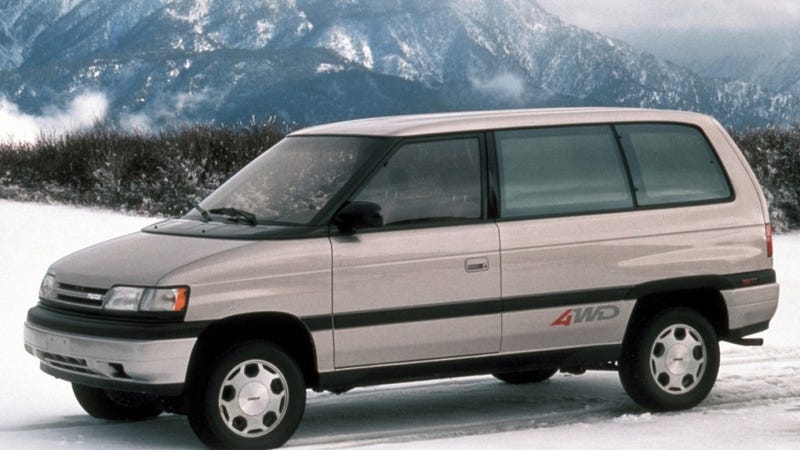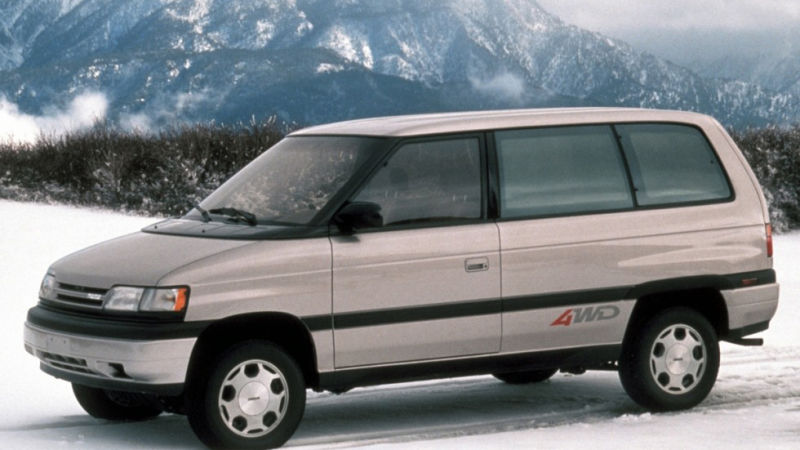
It’s hard to put the success of the Mazda Miata into perspective, a unbelievably huge hit from a rather small company. How small? Small enough that Mazda didn’t have enough money to to put out the Miata and a minivan at the same time, and it chose the minivan first.
This is the Mazda MPV, a multi-purpose vehicle if you want to use the cool terminology of the day. It has four doors that all open normally (no sliding doors). It uses the basic architecture not of a front-wheel drive sedan, but instead of the full-size sedan Mazda 929 of the day, meaning it came with rear-wheel drive or optional all-wheel drive.
It debuted in 1988 while the smash hit Miata came in 1989. The why of it is interesting.
Advertisement
The Japanese Domestic Market at the time was busily going bonkers in the start of the Bubble Era, and what was hot were little SUV/MPV things like you’d get from Mitsubishi. And indeed, Mitsubishi sales skyrocketed and everyone else (including Mazda) wanted in on that action.
It was at this time that Mazda internally proposed three different projects, as former Mazda product guru Bob Hall explained to me on the phone the other day. There was the Miata, there was the MPV and there was a midengine four-door economy car, not greatly unlike the Honda Z that came out in the coming decade.
Advertisement
(No, I have not been able to find any drawings of this midengine economy car. I have asked. I have asked everyone. If you have any, my contact info is at the bottom of this article.)
Mazda engineers couldn’t quite get the midengine car figured out—if the engine sat upright there would be no room for anyone in the back seats. If the engine was laid flat it would have oiling problems. If Mazda fixed the oiling problems on the engine for laying flat, the parts wouldn’t be common with Mazda’s other upright engines and the whole project would get much too expensive. That shelved the midengine car.
So a choice had to be made between the Miata and the MPV, as then-Mazda designer Tom Matano confirmed to me in another call. “The resources of Mazda at the time were such that you couldn’t do two new vehicles at the same time.”
Advertisement
And between the two, Bob explained, the MPV was the easy and safe choice, one that Mazda didn’t have the resources to ignore.
What was odd is that though the final vehicle ended up this big and chunky rear- or all-wheel drive vehicle, something that modern adventure driving enthusiasts have kind of latched onto, the original proposal was indeed for a V6 front-driver, something that was more standard, more efficient and may have sold better.
Advertisement
“I had done the proposal for it,” Bob told me. “It was one of the last things I designed. All the glass was flat. Even the windshield was flat.” This got the thing the nickname among the staff of “the giant panda.” The problem was that the program manager was a truck guy and refused to believe that a V6 would work with front-wheel drive, and got the thing on the 929 platform, so it ended up much bigger and heavier than initially planned. “I wish I could remember the bastard’s name,” Bob laughed, remembering a story. “Let’s call him Tanaka. Tanaka is Smith in Japanese.”
“A friend at Chrysler faxed me the T100 with the FWD V6 layout six months before it came out,” Bob gushed. “I white outed all the Chrysler stuff and at a presentation, I showed that this was the V6 that’s coming out next year. Quiet. Yamamoto… [the engineer-turned boss of Mazda at the time] … I remember this vividly … says ‘I’m sure the only reason they did it was they didn’t ask Mr. Tanaka that it was impossible.’”
“Yamamoto laughed,” Bob said. “He fucking laughed. Probably saved my job.”
As it was, the Miata came out right at the very pointiest peak of the Bubble Era, in 1989 and sales took off. Bob figured it wasn’t necessarily a bad thing. If it had come out in 1988 it might have been too soon and flopped. We’ll never know.
Advertisement
But at least now I understand how small Mazda was at that time, a little company punching up at the giants around it.















